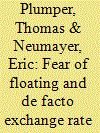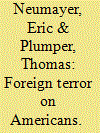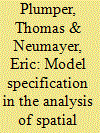|
|
|
Sort Order |
|
|
|
Items / Page
|
|
|
|
|
|
|
| Srl | Item |
| 1 |
ID:
109583


|
|
|
|
|
| Publication |
2011.
|
| Summary/Abstract |
This paper adopts and develops the "fear of floating" theory to explain the decision to implement a de facto peg, the choice of anchor currency among multiple key currencies, and the role of central bank independence for these choices. We argue that since exchange rate depreciations are passed-through into higher prices of imported goods, avoiding the import of inflation provides an important motive to de facto peg the exchange rate in import-dependent countries. This study shows that the choice of anchor currency is determined by the degree of dependence of the potentially pegging country on imports from the key currency country and on imports from the key currency area, consisting of all countries which have already pegged to this key currency. The fear of floating approach also predicts that countries with more independent central banks are more likely to de facto peg their exchange rate since independent central banks are more averse to inflation than governments and can de facto peg a country's exchange rate independently of the government.
|
|
|
|
|
|
|
|
|
|
|
|
|
|
|
|
| 2 |
ID:
102505


|
|
|
|
|
| Publication |
2011.
|
| Summary/Abstract |
Americans are a major target of international terrorism. Yet, terrorists from some countries are much more likely to attack American citizens than terrorists from other countries. Similarly, anti-American terrorism from a specific foreign country is much more prevalent during certain periods than others. This article develops a rational theory of international terrorism, which argues that attacking foreign nationals is of strategic value to terrorists even if they ultimately aim at gaining political influence in their home country. Attacking foreigners is the more attractive to domestic terrorists the more the terrorists' home government depends on military support from the foreign country. Applied to the US case, our theory predicts that more anti-American terrorism emanates from countries that receive more US military aid and arms transfers and in which more American military personnel are stationed, all relative to the country's own military capacity. Estimations from a directed country dyad sample over the period 1978 to 2005 support the predictions of our theory for both terrorist incidents involving Americans and terrorist killings of Americans as dependent variables. These results are robust to a wide range of changes to the empirical research design.
|
|
|
|
|
|
|
|
|
|
|
|
|
|
|
|
| 3 |
ID:
094966


|
|
|
|
|
| Publication |
2010.
|
| Summary/Abstract |
Terrorism is an instrument for groups that cannot achieve their political goals legally. One important strategic function of terrorism is to weaken the government - either directly by attacking representatives or supporters of the government or indirectly by causing a political response that is unpopular among the population. Often, however, political stability of the home government is buttressed by foreign powers. In this case, the terrorists can have a strategic interest in attacking nationals of these foreign countries. This article analyses this logic by looking at international alliances as a proxy for international support. If the friend of my enemy is my enemy, then terror entrepreneurs, which seek to overthrow their home country's government (the enemy), may find it attractive to target nationals of the foreign allies of their country (the friends of the enemy). The theory in this article predicts that attacking nationals of a foreign ally is particularly attractive if this ally is militarily more powerful than the home country. Moreover, the combined effect of alliance and relative power differentials becomes stronger the more democratic the ally and becomes weaker the more democratic the terrorists' home country. Empirical support for the hypotheses in this article is found in an analysis of a directed country dyad sample of international terrorism.
|
|
|
|
|
|
|
|
|
|
|
|
|
|
|
|
| 4 |
ID:
094983


|
|
|
|
|
| Publication |
2010.
|
| Summary/Abstract |
The recent surge in studies analysing spatial dependence in political science has gone hand-in-hand with increased attention paid to the choice of estimation technique. In comparison, specification choice has been relatively neglected, even though it leads to equally, if not more, serious inference problems. In this article four specification issues are analysed. It is argued that to avoid biased estimates of the spatial effects, researchers need to consider carefully how to model temporal dynamics, common trends and common shocks, as well as how to account for spatial clustering and unobserved spatial heterogeneity. The remaining two specification issues relate to the weighting matrix employed for the creation of spatial effects: whether it should be row-standardised and what functional form to choose for this matrix. The importance of these specification issues is demonstrated by replicating Hays' model of spatial dependence in international capital tax rate competition. Seemingly small changes to model specification have major impacts on the spatial effect estimates. It is recommended that spatial analysts develop their theories of spatial dependencies further to provide more guidance on the specification of the estimation model. In the absence of sufficiently developed theories, the robustness of results to specification changes needs to be demonstrated.
|
|
|
|
|
|
|
|
|
|
|
|
|
|
|
|
|
|
|
|
|